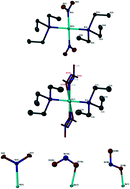Photoactivated linkage isomerism in single crystals of nickel, palladium and platinum di-nitro complexes – a photocrystallographic investigation†‡
Abstract
Low temperature, single crystal photocrystallographic studies have been carried out on four square planar Group 10 complexes [Ni(PEt3)2(NO2)2] 1, [Pd(PPh3)2(NO2)2] 2, [Pd(AsPh3)2(NO2)2] 3 and [Pt(PPh3)2(NO2)2] 4, in which the two nitro groups adopt the trans configuration. Irradiation with UV light, at 100 K, of single crystals of complexes 1–3 photoisomerise from the η1-NO2 nitro form to the η1-ONO nitrito form occurred. Complex 1 underwent 25% conversion to the nitrito form before crystal

- This article is part of the themed collection: Dalton Discussion 13: Inorganic photophysics and photochemistry –Fundamentals and applications

 Please wait while we load your content...
Please wait while we load your content...